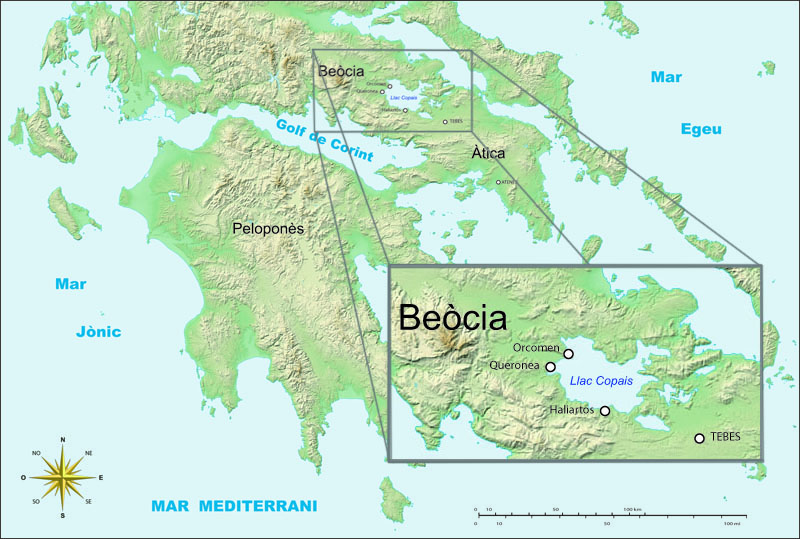|
Mount Tilphossium
Tilphossium or Tilphossion ( grc, Τιλφώσσιον or Τιλφωσσαῖον), or Tilphusium or Tilphousion (Τιλφούσιον), was a mountain on the southern side of Lake Copais, between the plains of Haliartus and Coroneia, maybe regarded as the furthest offshoot of Mount Helicon, with which it is connected by means of Mount Leibethrium. At the foot of the hill was the small fountain Tilphossa or Tilphussa, where the seer Tiresias In Greek mythology, Tiresias (; grc, Τειρεσίας, Teiresías) was a blind prophet of Apollo in Thebes, famous for clairvoyance and for being transformed into a woman for seven years. He was the son of the shepherd Everes and the nym ... is said to have died. The hill bears the form of a letter T, with its foot turned towards the north. From its position between the lake and Leibethrium, there is a narrow pass on either side of the hill. The pass between Tilphossium and the lake was one of great importance in antiquity, as the h ... [...More Info...] [...Related Items...] OR: [Wikipedia] [Google] [Baidu] |
Lake Copais
Lake Copais, also spelled Kopais or Kopaida ( grc, Κωπαΐς; ell, Κωπαΐδα), was a lake in the centre of Boeotia, Greece, west of Thebes. It was drained in the late 19th century. It is now flat dry land and is still known as Kopaida. A one-time island in the lake was modified in ancient times into a megalithic citadel, now called Gla, though its ancient name is not known. It may be the city of Arne mentioned by Homer. Drainage When the lake existed, the towns of Haliartus, Orchomenus, and Chaeronea were on its shores. Rivers feeding the lake included the Cephissus, Termessus and Triton. The lake was (and is) surrounded by fertile land, but the lake increasingly encroached on the surrounding land because of inadequate drainage. In response to this, in 1867–1887 Scots and French engineers reclaimed the land for the British Lake Copais Company, by building channels to drain water from the lake to the Cephissus and from there to Lake Yliki (Ylíki Limní, ancient Hy ... [...More Info...] [...Related Items...] OR: [Wikipedia] [Google] [Baidu] |
Haliartus
Haliartus or Haliartos (), also known as Ariartus or Ariartos or Hariartus or Hariartos (Ἀρίαρτος or Ἁρίαρτος), was a town of ancient Boeotia, and one of the cities of the Boeotian League. It was situated on the southern side of Lake Copais in a pass between the mountain and the lake. It is mentioned in the Catalogue of Ships in the ''Iliad'' by Homer, who gives it the epithet ποιήεις (grassy) in consequence of its well-watered meadows. In the Peloponnesian War appears as one of the chief cities of Boeotia. It is chiefly memorable in history on account of the Battle of Haliartus fought under its walls between Lysander and the Thebans, in which the former was slain, 395 BCE. In 171 BCE Haliartus was destroyed a second time. Having espoused the cause of Perseus of Macedon, it was taken by the Roman praetor Lucretius, who sold the inhabitants as slaves, carried off its statues, paintings, and other works of art, and razed it to the ground. Its territo ... [...More Info...] [...Related Items...] OR: [Wikipedia] [Google] [Baidu] |
Coroneia (Boeotia)
Coroneia ( grc-gre, Κορώνεια), or Coronea, was a town of ancient Boeotia, and a member of the Boeotian League. It is described by Strabo as situated upon a height near Mount Helicon; its territory was called Κορωνειακή. The town stood upon an insulated hill at the entrance of a valley leading southwards to Mt. Helicon, the principal summit of which is seen at the head of the valley. From this hill there was a fine view over the Lake Copais, and at its foot there was a broad plain extending as far as the marshes of the lake. On either side of the hill flowed two streams, one on the eastern or right hand side, called Coralius or Cuarius, and the other on the left, named Phalarus: a tributary of the latter was the Isomantus or Hoplias. Coroneia is said to have been founded by the Boeotians from Arne in Thessaly, after they had been driven out of their original homes by the Thessalians; and they appear to have called it Coroneia after the Thessalian town of this na ... [...More Info...] [...Related Items...] OR: [Wikipedia] [Google] [Baidu] |
Mount Helicon
Mount Helicon ( grc, Ἑλικών; ell, Ελικώνας) is a mountain in the region of Thespiai in Boeotia, Greece, celebrated in Greek mythology. With an altitude of , it is located approximately from the north coast of the Gulf of Corinth. Some researchers maintain that Helicon was also the Greek name of mount Rocca Salvatesta in Sicily as a river started from it was called also Helikon. Greek mythology In Greek mythology, two springs sacred to the Muses were located here: the Aganippe and the Hippocrene, both of which bear "horse" (ἵππος ''híppos'') in their names. In a related myth, the Hippocrene spring was created when the winged horse Pegasus aimed his hoof at a rock, striking it with such force that the spring burst from the spot. On Mount Helicon too was the spring where Narcissus was inspired by his own beauty. Mount Helicon and the Hippocrene spring were considered to be a source of poetic inspiration. In the late seventh century BCE, the poet Hesiod plac ... [...More Info...] [...Related Items...] OR: [Wikipedia] [Google] [Baidu] |
Mount Leibethrium
Mount is often used as part of the name of specific mountains, e.g. Mount Everest. Mount or Mounts may also refer to: Places * Mount, Cornwall, a village in Warleggan parish, England * Mount, Perranzabuloe, a hamlet in Perranzabuloe parish, Cornwall, England * Mounts, Indiana, a community in Gibson County, Indiana, United States People * Mount (surname) * William L. Mounts (1862–1929), American lawyer and politician Computing and software * Mount (computing), the process of making a file system accessible * Mount (Unix), the utility in Unix-like operating systems which mounts file systems Displays and equipment * Mount, a fixed point for attaching equipment, such as a hardpoint on an airframe * Mounting board, in picture framing * Mount, a hanging scroll for mounting paintings * Mount, to display an item on a heavy backing such as foamcore, e.g.: ** To pin a biological specimen, on a heavy backing in a stretched stable position for ease of dissection or display ** To p ... [...More Info...] [...Related Items...] OR: [Wikipedia] [Google] [Baidu] |
Tiresias
In Greek mythology, Tiresias (; grc, Τειρεσίας, Teiresías) was a blind prophet of Apollo in Thebes, famous for clairvoyance and for being transformed into a woman for seven years. He was the son of the shepherd Everes and the nymph Chariclo. Tiresias participated fully in seven generations in Thebes, beginning as advisor to Cadmus himself. Mythology Eighteen allusions to mythic Tiresias, noted by Luc Brisson, fall into three groups: the first recounts Tiresias' sex-change episode and later his encounter with Zeus and Hera; the second group recounts his blinding by Athena; the third, all but lost, seems to have recounted the misadventures of Tiresias. Blindness and gift of prophecy Like other oracles, how Tiresias obtained his information varied: sometimes, he would receive visions; other times he would listen for the songs of birds, or ask for a description of visions and pictures appearing within the smoke of burnt offerings or entrails, and so interpret them. ... [...More Info...] [...Related Items...] OR: [Wikipedia] [Google] [Baidu] |
Thebes, Greece
Thebes (; ell, Θήβα, ''Thíva'' ; grc, Θῆβαι, ''Thêbai'' .) is a city in Boeotia, Central Greece. It played an important role in Greek myths, as the site of the stories of Cadmus, Oedipus, Dionysus, Heracles and others. Archaeological excavations in and around Thebes have revealed a Mycenaean settlement and clay tablets written in the Linear B script, indicating the importance of the site in the Bronze Age. Thebes was the largest city of the ancient region of Boeotia and was the leader of the Boeotian confederacy. It was a major rival of ancient Athens, and sided with the Persians during the 480 BC invasion under Xerxes I. Theban forces under the command of Epaminondas ended Spartan hegemony at the Battle of Leuctra in 371 BC, with the Sacred Band of Thebes, an elite military unit of male lovers celebrated as instrumental there. Macedonia would rise in power at the Battle of Chaeronea in 338 BC, bringing decisive victory to Philip II over an alliance of Thebes ... [...More Info...] [...Related Items...] OR: [Wikipedia] [Google] [Baidu] |
Tilphossaeum
Tilphossaeum or Tilphossaion ( grc, Τιλφώσσαιον), also Tilphosaeum or Tilphosaion (Τιλφώσαιον or Τιλϕωσαΐον), or Tilphusium or Tilphousion (Τιλφούσιον), was a fortress in ancient Boeotia that commanded the narrow pass between Mount Tilphossium and Lake Copais Lake Copais, also spelled Kopais or Kopaida ( grc, Κωπαΐς; ell, Κωπαΐδα), was a lake in the centre of Boeotia, Greece, west of Thebes. It was drained in the late 19th century. It is now flat dry land and is still known as Kopaida. ..., which pass was one of great importance in antiquity, as the high road from northern Greece to Thebes passed through it. Its site is tentatively located near modern Palaiothiva. References Populated places in ancient Boeotia Former populated places in Greece {{AncientBoeotia-geo-stub ... [...More Info...] [...Related Items...] OR: [Wikipedia] [Google] [Baidu] |
Geography Of Ancient Boeotia
Geography (from Greek: , ''geographia''. Combination of Greek words ‘Geo’ (The Earth) and ‘Graphien’ (to describe), literally "earth description") is a field of science devoted to the study of the lands, features, inhabitants, and phenomena of Earth. The first recorded use of the word γεωγραφία was as a title of a book by Greek scholar Eratosthenes (276–194 BC). Geography is an all-encompassing discipline that seeks an understanding of Earth and its human and natural complexities—not merely where objects are, but also how they have changed and come to be. While geography is specific to Earth, many concepts can be applied more broadly to other celestial bodies in the field of planetary science. One such concept, the first law of geography, proposed by Waldo Tobler, is "everything is related to everything else, but near things are more related than distant things." Geography has been called "the world discipline" and "the bridge between the human and ... [...More Info...] [...Related Items...] OR: [Wikipedia] [Google] [Baidu] |


